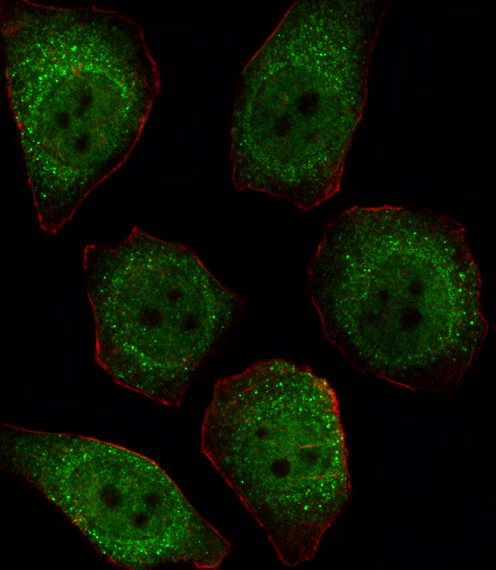Protein Phosphatase 1 beta (PPP1CB) Antibody (C-term)
Purified Rabbit Polyclonal Antibody (Pab)
- SPECIFICATION
- CITATIONS
- PROTOCOLS
- BACKGROUND

Application
| WB, IF, E |
|---|---|
| Primary Accession | P62140 |
| Other Accession | Q6GQL2, P62142, P62143, P61292, P62141, P62207, Q3SWW9 |
| Reactivity | Human |
| Predicted | Bovine, Chicken, Mouse, Pig, Rabbit, Rat, Xenopus |
| Host | Rabbit |
| Clonality | Polyclonal |
| Isotype | Rabbit IgG |
| Calculated MW | 37187 Da |
| Antigen Region | 286-315 aa |
| Gene ID | 5500 |
|---|---|
| Other Names | Serine/threonine-protein phosphatase PP1-beta catalytic subunit, PP-1B, PPP1CD, PPP1CB |
| Target/Specificity | This Protein Phosphatase 1 beta (PPP1CB) antibody is generated from rabbits immunized with a KLH conjugated synthetic peptide between 286-315 amino acids from the C-terminal region of human Protein Phosphatase 1 beta (PPP1CB). |
| Dilution | IF~~1:10~50 WB~~1:1000 |
| Format | Purified polyclonal antibody supplied in PBS with 0.09% (W/V) sodium azide. This antibody is prepared by Saturated Ammonium Sulfate (SAS) precipitation followed by dialysis against PBS. |
| Storage | Maintain refrigerated at 2-8°C for up to 2 weeks. For long term storage store at -20°C in small aliquots to prevent freeze-thaw cycles. |
| Precautions | Protein Phosphatase 1 beta (PPP1CB) Antibody (C-term) is for research use only and not for use in diagnostic or therapeutic procedures. |
| Name | PPP1CB |
|---|---|
| Function | Protein phosphatase that associates with over 200 regulatory proteins to form highly specific holoenzymes which dephosphorylate hundreds of biological targets. Protein phosphatase (PP1) is essential for cell division, it participates in the regulation of glycogen metabolism, muscle contractility and protein synthesis. Involved in regulation of ionic conductances and long-term synaptic plasticity. Component of the PTW/PP1 phosphatase complex, which plays a role in the control of chromatin structure and cell cycle progression during the transition from mitosis into interphase. In balance with CSNK1D and CSNK1E, determines the circadian period length, through the regulation of the speed and rhythmicity of PER1 and PER2 phosphorylation. May dephosphorylate CSNK1D and CSNK1E. Dephosphorylates the 'Ser-418' residue of FOXP3 in regulatory T-cells (Treg) from patients with rheumatoid arthritis, thereby inactivating FOXP3 and rendering Treg cells functionally defective (PubMed:23396208). Core component of the SHOC2-MRAS-PP1c (SMP) holophosphatase complex that regulates the MAPK pathway activation (PubMed:35768504, PubMed:35831509, PubMed:36175670). The SMP complex specifically dephosphorylates the inhibitory phosphorylation at 'Ser-259' of RAF1 kinase, 'Ser-365' of BRAF kinase and 'Ser-214' of ARAF kinase, stimulating their kinase activities (PubMed:35768504, PubMed:35831509, PubMed:36175670). The SMP complex enhances the dephosphorylation activity and substrate specificity of PP1c (PubMed:35768504, PubMed:36175670). |
| Cellular Location | Cytoplasm. Nucleus. Nucleus, nucleoplasm. Nucleus, nucleolus. Note=Highly mobile in cells and can be relocalized through interaction with targeting subunits. In the presence of PPP1R8 relocalizes from the nucleus to nuclear speckles. |

Thousands of laboratories across the world have published research that depended on the performance of antibodies from Abcepta to advance their research. Check out links to articles that cite our products in major peer-reviewed journals, organized by research category.
info@abcepta.com, and receive a free "I Love Antibodies" mug.
Provided below are standard protocols that you may find useful for product applications.
Background
Protein phosphatase-1 (PP1) is 1 of 4 major serine/threonine-specific protein phosphatases involved in the dephosphorylation of a variety of proteins. These enzymes work in opposition to the protein kinases to control the level of phosphorylation. Protein phosphatase (PP1) is essential for cell division, and it participates in the regulation of glycogen metabolism, muscle contractility and protein synthesis, as well as in regulation of ionic conductances and long-term synaptic plasticity. PP1 has 3 catalytic subunits, designated alpha (PPP1CA), beta (PPP1CB), and gamma (PPP1CC).
If you have used an Abcepta product and would like to share how it has performed, please click on the "Submit Review" button and provide the requested information. Our staff will examine and post your review and contact you if needed.
If you have any additional inquiries please email technical services at tech@abcepta.com.














 Foundational characteristics of cancer include proliferation, angiogenesis, migration, evasion of apoptosis, and cellular immortality. Find key markers for these cellular processes and antibodies to detect them.
Foundational characteristics of cancer include proliferation, angiogenesis, migration, evasion of apoptosis, and cellular immortality. Find key markers for these cellular processes and antibodies to detect them. The SUMOplot™ Analysis Program predicts and scores sumoylation sites in your protein. SUMOylation is a post-translational modification involved in various cellular processes, such as nuclear-cytosolic transport, transcriptional regulation, apoptosis, protein stability, response to stress, and progression through the cell cycle.
The SUMOplot™ Analysis Program predicts and scores sumoylation sites in your protein. SUMOylation is a post-translational modification involved in various cellular processes, such as nuclear-cytosolic transport, transcriptional regulation, apoptosis, protein stability, response to stress, and progression through the cell cycle. The Autophagy Receptor Motif Plotter predicts and scores autophagy receptor binding sites in your protein. Identifying proteins connected to this pathway is critical to understanding the role of autophagy in physiological as well as pathological processes such as development, differentiation, neurodegenerative diseases, stress, infection, and cancer.
The Autophagy Receptor Motif Plotter predicts and scores autophagy receptor binding sites in your protein. Identifying proteins connected to this pathway is critical to understanding the role of autophagy in physiological as well as pathological processes such as development, differentiation, neurodegenerative diseases, stress, infection, and cancer.



